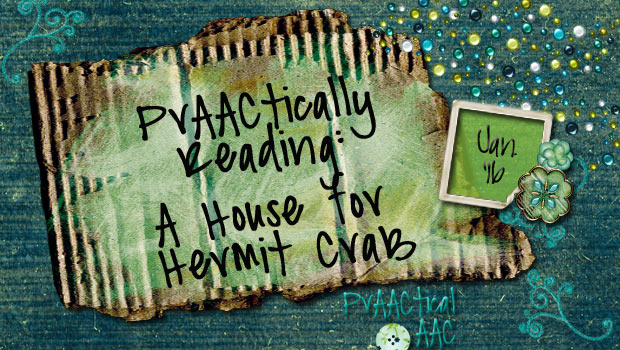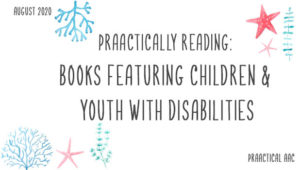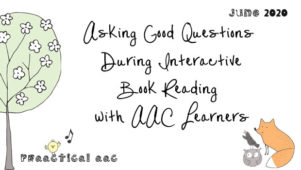PrAACtically Reading: A House for Hermit Crab

Storybook reading is rich with potential for building AAC, language, and literacy skills. An added bonus: It’s an activity that educators, therapists, and families can all use and enjoy. In this post, we explore ways to use A House for Hermit Crab, by Eric Carle, for AAC and language learning.
Key Instructional Strategies
Having an engaging book gives us a good start on the lesson, but the learning comes from the interaction. Shared reading can be done in therapy one-on-one or as a group in class. Either way, the adult leading the activity will need to be well-versed in instructional strategies that facilitate AAC learning. These include:
Goal Areas: Language and Communication
There are lots and lots of ways to use this book for literacy learning, but in this post we’ll focus more on the development of communication and language skills. Here are some goal areas that can be targeted with this story.
Semantics: Increased use of core words; Improved understanding of academic (Tier 2) vocabulary
- Year of Core Vocabulary: different, mine, not/don’t, want, what, you; are, clean, house, look, see, to, when, yes (see resources for this set of core words here)
- Academic Vocabulary: attack, decorate, dim, fierce, gently, gloomy, grateful, murky, plain, safe, snug, tidy
- Related Vocabulary: Months of the year
Morpho-syntax: Expanding from MLU from single words to longer sentences; Use of conjunctions; Use of noun or verb phrases
Pragmatic Functions: Asking questions; labeling; answering questions; retelling; requesting attention, help, or actions
Other Language Concepts: “just right”; Multiple meanings for the word ‘crab’
Thematic Learning
This book is a good fit for a number of different themes. On a more concrete level, A House for Hermit Crab works well for units addressing:
- Ocean and sea life
- Homes and communities
- Recycling and re-purposing
On another level, this book is well-suited for themes geared to build social-emotional development. The content and plot set the stage for units that focus on:
- Dealing with change
- Making decisions
- Moving to a new home
Engaging the Learner
Despite the fun characters and interesting story line, we still may have to work hard to keep our learners engaged. Here are some tips for making that happen.
- Keep it interactive.
- Create communication opportunities, but don’t overuse questions. Many learners who would otherwise love interactive story-reading get turned off when we ask too many questions.
- When you do ask questions, keep them focused on the salient aspects of the story and illustrations. Don’t ask what color something is, for example, just because the learner has colors in his/her SGD. Focus on what is interesting, novel, or unexpected.
- Boost the ‘fun factor’ by using different voices for the sea creatures.
- Print out pictures of characters (resources below) and make into props.
- Act out the story with a DIY flannel board (individual lap boards or larger group-sized boards) and characters
Extension Activities
The learning and fun doesn’t have to stop with the story. Here are some activity suggestions to keep it going.
- Poetry: Don’t Be a Drab Crab poem frame by Lynn Kinsinger
- Put on a skit: “Moving Day” by Robert Kalan Readers Theater from Jennifer McKnight
- Learn about hermit crab care
- Build a crabitat http://www.wikihow.com/Create-a-Hermit-Crab-Habitat
- Art: Lots of great activity ideas here
Related Materials
- House for Hermit Crab Sequencing by Pam Sydney (via Boardmaker Online)
- Main idea, sorting chart and other activities by Kim Hall (via Boardmaker Online)
- Electronic version of the book by Kimberly Sutton (via Boardmaker Online)
- Matching and sorting by Joy Adams (via Boardmaker Online)
- House for Hermit Crab Activity Pack
- Learn more about hermit crabs with Teach 123 Michelle
- Printables and activity ideas from The Best Kids Books site
- Puppet printables and other activity materials by The Educators’ Spin on It
“This is a little kid’s book. Can I use it with older students, too?”
Possibly. In general, we lean toward books that are more age respectful like the ones suggested by Erin Sheldon in this post. Like any set of guidelines, there are occasional exceptions and I, for one, have used children’s books with teens and adults. Stay tuned for more about that in a future post.
There’s lot of good AAC learning that can take place during this crab’s journey to find just the right home. If you use “A House for Hermit Crab” with your AAC learners, please come back and tell us about it.
Filed under: PrAACtical Thinking
Tagged With: reading
This post was written by Carole Zangari





2 Comments
Love Eric Carle! Thank you for these ideas! Looking forward to sharing. And I love the website. I’m on my phone, but it looks fresh and new!
Rachael
Thanks, Rachael! Eric Carle is one of my favorites!